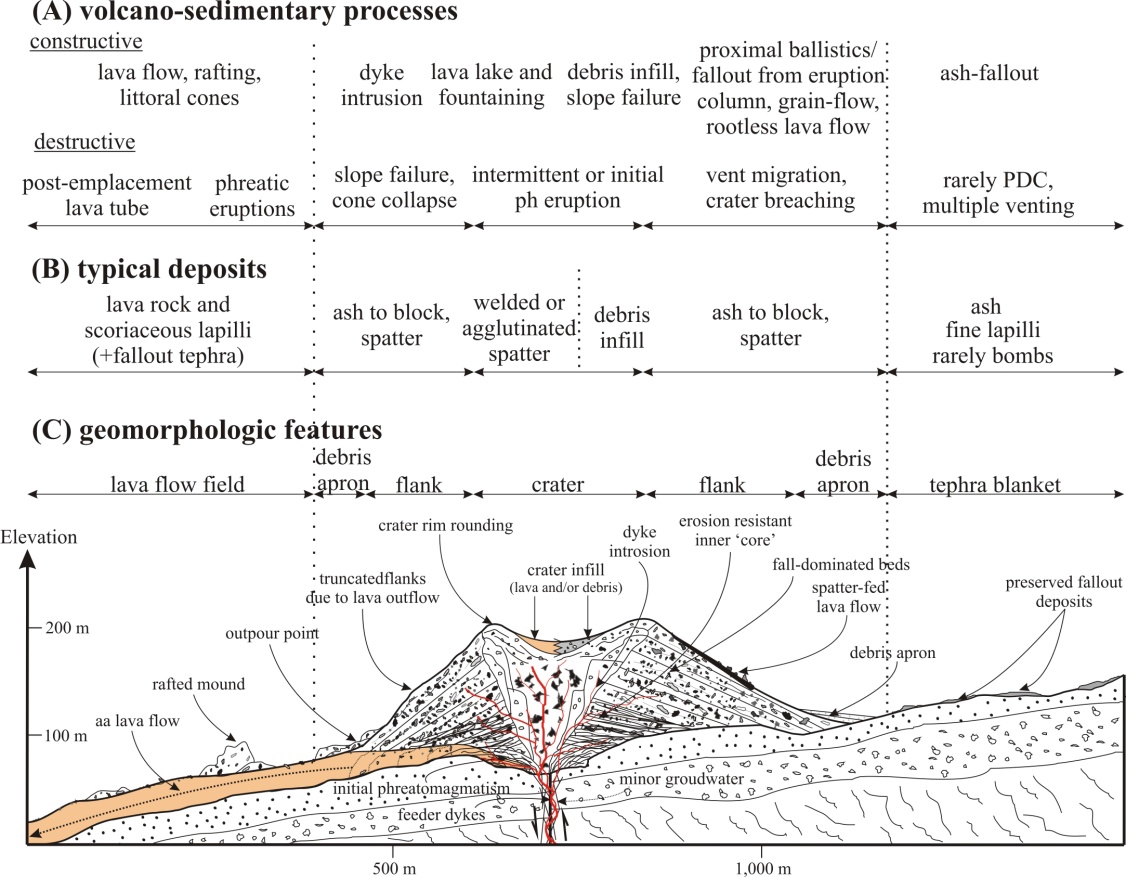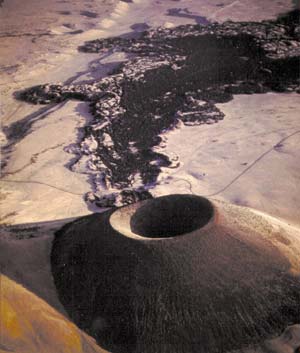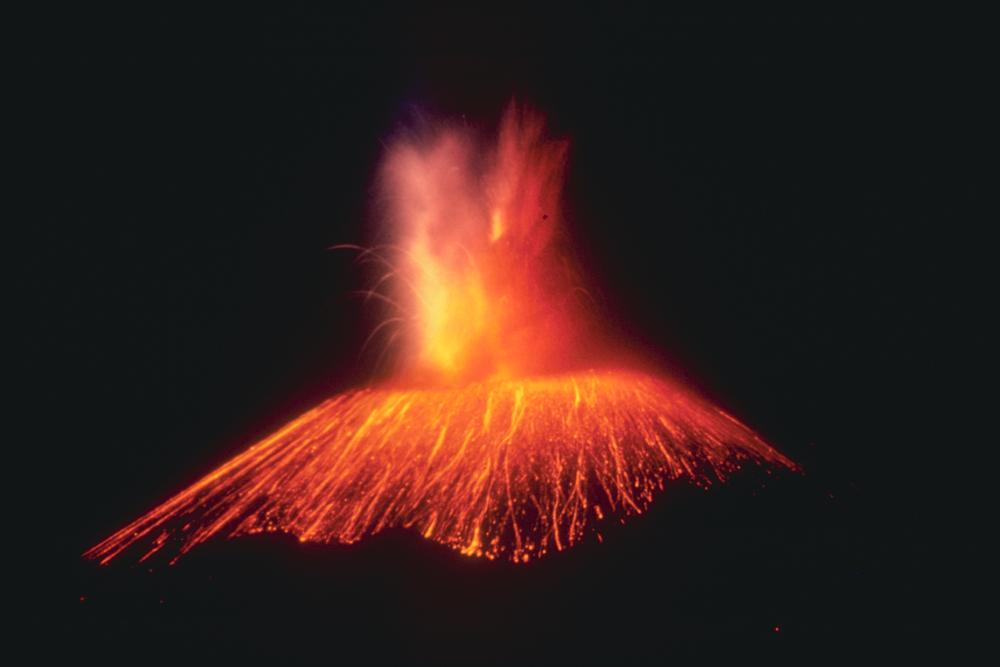Cinder cone on:
[Wikipedia]
[Google]
[Amazon]
 A cinder cone (or scoria cone) is a steep conical hill of loose pyroclastic fragments, such as volcanic clinkers, volcanic ash, or scoria that has been built around a volcanic vent. The pyroclastic fragments are formed by explosive eruptions or
A cinder cone (or scoria cone) is a steep conical hill of loose pyroclastic fragments, such as volcanic clinkers, volcanic ash, or scoria that has been built around a volcanic vent. The pyroclastic fragments are formed by explosive eruptions or
 Cinder cones range in size from tens to hundreds of meters tall and often have a bowl-shaped crater at the summit. They are composed of loose pyroclastic material ( cinder or scoria), which distinguishes them from ''
Cinder cones range in size from tens to hundreds of meters tall and often have a bowl-shaped crater at the summit. They are composed of loose pyroclastic material ( cinder or scoria), which distinguishes them from ''
 Basaltic cinder cones are the most characteristic type of volcano associated with
Basaltic cinder cones are the most characteristic type of volcano associated with
 The size and shape of cinder cones depend on environmental properties as different gravity and/or atmospheric pressure might change the dispersion of ejected scoria particles. For example, cinder cones on Mars seem to be more than two times wider than terrestrial analogues as lower atmospheric pressure and gravity enable wider dispersion of ejected particles over a larger area. Therefore, it seems that erupted amount of material is not sufficient on Mars for the flank slopes to attain the
The size and shape of cinder cones depend on environmental properties as different gravity and/or atmospheric pressure might change the dispersion of ejected scoria particles. For example, cinder cones on Mars seem to be more than two times wider than terrestrial analogues as lower atmospheric pressure and gravity enable wider dispersion of ejected particles over a larger area. Therefore, it seems that erupted amount of material is not sufficient on Mars for the flank slopes to attain the
 Some cinder cones are monogenetic, forming from a single short eruptive episode that produces a very small volume of lava. The eruption typically last just weeks or months, but can occasionally last fifteen years or longer. Parícutin in Mexico, Diamond Head,
Some cinder cones are monogenetic, forming from a single short eruptive episode that produces a very small volume of lava. The eruption typically last just weeks or months, but can occasionally last fifteen years or longer. Parícutin in Mexico, Diamond Head,
 A cinder cone (or scoria cone) is a steep conical hill of loose pyroclastic fragments, such as volcanic clinkers, volcanic ash, or scoria that has been built around a volcanic vent. The pyroclastic fragments are formed by explosive eruptions or
A cinder cone (or scoria cone) is a steep conical hill of loose pyroclastic fragments, such as volcanic clinkers, volcanic ash, or scoria that has been built around a volcanic vent. The pyroclastic fragments are formed by explosive eruptions or lava fountain
Lava is molten or partially molten rock ( magma) that has been expelled from the interior of a terrestrial planet (such as Earth) or a moon onto its surface. Lava may be erupted at a volcano or through a fracture in the crust, on land ...
s from a single, typically cylindrical, vent. As the gas-charged lava is blown violently into the air, it breaks into small fragments that solidify and fall as either cinders, clinkers, or scoria around the vent to form a cone that often is symmetrical; with slopes between 30 and 40°; and a nearly circular ground plan. Most cinder cones have a bowl-shaped crater at the summit.
Mechanics of eruption
 Cinder cones range in size from tens to hundreds of meters tall and often have a bowl-shaped crater at the summit. They are composed of loose pyroclastic material ( cinder or scoria), which distinguishes them from ''
Cinder cones range in size from tens to hundreds of meters tall and often have a bowl-shaped crater at the summit. They are composed of loose pyroclastic material ( cinder or scoria), which distinguishes them from ''spatter cones
Volcanic cones are among the simplest volcanic landforms. They are built by ejecta from a volcanic vent, piling up around the vent in the shape of a cone with a central crater. Volcanic cones are of different types, depending upon the nature and ...
'', which are composed of agglomerated volcanic bombs.
The pyroclastic material making up a cinder cone is usually basalt
Basalt (; ) is an aphanitic (fine-grained) extrusive igneous rock formed from the rapid cooling of low-viscosity lava rich in magnesium and iron (mafic lava) exposed at or very near the surface of a rocky planet or moon. More than 90 ...
ic to andesitic in composition. It is often glass
Glass is a non- crystalline, often transparent, amorphous solid that has widespread practical, technological, and decorative use in, for example, window panes, tableware, and optics. Glass is most often formed by rapid cooling (quenchin ...
y and contains numerous gas bubbles "frozen" into place as magma
Magma () is the molten or semi-molten natural material from which all igneous rocks are formed. Magma is found beneath the surface of the Earth, and evidence of magmatism has also been discovered on other terrestrial planets and some natura ...
exploded into the air and then cooled quickly. Lava fragments larger than 64 mm across, known as volcanic bombs, are also a common product of cinder cone eruptions.
The growth of a cinder cone may be divided into four stages. In the first stage, a low-rimmed scoria ring forms around the erupting event. During the second stage, the rim is built up and a talus slope
Scree is a collection of broken rock fragments at the base of a cliff or other steep rocky mass that has accumulated through periodic rockfall. Landforms associated with these materials are often called talus deposits. Talus deposits typically ha ...
begins to form outside the rim. The third stage is characterized by slumping and blast that destroy the original rim, while the fourth stage is characterized by the buildup of talus beyond the zone where cinder falls to the surface (the ''ballistic zone'').
During the waning stage of a cinder cone eruption, the magma has lost most of its gas content. This gas-depleted magma does not fountain but oozes quietly into the crater or beneath the base of the cone as lava. Lava rarely issues from the top (except as a fountain) because the loose, uncemented cinders are too weak to support the pressure exerted by molten rock as it rises toward the surface through the central vent. Because it contains so few gas bubbles, the molten lava is denser than the bubble-rich cinders. Thus, it often burrows out along the bottom of the cinder cone, lifting the less dense cinders like corks on water, and advances outward, creating a lava flow around the cone's base. When the eruption ends, a symmetrical cone of cinders sits at the center of a surrounding pad of lava. If the crater is fully breached, the remaining walls form an amphitheater or horseshoe shape around the vent.
Occurrence
intraplate volcanism
Intraplate volcanism is volcanism that takes place away from the margins of tectonic plates. Most volcanic activity takes place on plate margins, and there is broad consensus among geologists that this activity is explained well by the theory of ...
. They are particularly common in association with alkaline magmatism, in which the erupted lava is enriched in sodium
Sodium is a chemical element with the symbol Na (from Latin ''natrium'') and atomic number 11. It is a soft, silvery-white, highly reactive metal. Sodium is an alkali metal, being in group 1 of the periodic table. Its only stable ...
and potassium oxides.
Cinder cones are also commonly found on the flanks of shield volcanoes, stratovolcanoes, and caldera
A caldera ( ) is a large cauldron-like hollow that forms shortly after the emptying of a magma chamber in a volcano eruption. When large volumes of magma are erupted over a short time, structural support for the rock above the magma chamber is ...
s. For example, geologists have identified nearly 100 cinder cones on the flanks of Mauna Kea
Mauna Kea ( or ; ; abbreviation for ''Mauna a Wākea''); is a dormant volcano on the island of Hawaii. Its peak is above sea level, making it the highest point in the state of Hawaii and second-highest peak of an island on Earth. The peak ...
, a shield volcano located on the island of Hawaii
Hawaii ( ; haw, Hawaii or ) is a state in the Western United States, located in the Pacific Ocean about from the U.S. mainland. It is the only U.S. state outside North America, the only state that is an archipelago, and the only stat ...
. Such cinder cones likely represent the final stages of activity of a mafic
A mafic mineral or rock is a silicate mineral or igneous rock rich in magnesium and iron. Most mafic minerals are dark in color, and common rock-forming mafic minerals include olivine, pyroxene, amphibole, and biotite. Common mafic rocks in ...
volcano. However, most volcanic cones formed in Hawaiian-type eruptions are spatter cones rather than cinder cones, due to the fluid nature of the lava.
The most famous cinder cone, Paricutin, grew out of a corn field in Mexico
Mexico (Spanish language, Spanish: México), officially the United Mexican States, is a List of sovereign states, country in the southern portion of North America. It is borders of Mexico, bordered to the north by the United States; to the so ...
in 1943 from a new vent. Eruptions continued for nine years, built the cone to a height of , and produced lava flows that covered .
The Earth's most historically active cinder cone is Cerro Negro in Nicaragua. It is part of a group of four young cinder cones NW of Las Pilas
Las Pilas (or El Hoyo) is a complex volcano located in the western part of Nicaragua. Part of a 30-km-long volcanic massif, Las Pilas has a series of well-preserved flank vents surrounding a central cone. Las Pilas last erupted in the 1950s and be ...
volcano. Since its initial eruption in 1850, it has erupted more than 20 times, most recently in 1995 and 1999.
Satellite images suggest that cinder cones occur on other terrestrial bodies in the solar system. On Mars, they have been reported on the flanks of Pavonis Mons
Pavonis Mons (Latin for "peacock mountain") is a large shield volcano located in the Tharsis region of the planet Mars. It is the middle member of a chain of three volcanic mountains (collectively known as the Tharsis Montes) that straddle the ...
in Tharsis
Tharsis () is a vast volcanic plateau centered near the equator in the western hemisphere of Mars. The region is home to the largest volcanoes in the Solar System, including the three enormous shield volcanoes Arsia Mons, Pavonis Mons, and As ...
, in the region of Hydraotes Chaos on the bottom of the Coprates Chasma
Coprates Chasma () is a huge canyon in the Coprates quadrangle of Mars, located at 13.4° south latitude and 61.4° west longitude, part of the Valles Marineris canyon system. It is long and was named after a classical albedo feature name. It ...
, or in the volcanic field Ulysses Colles
Ulysses Colles is an official name for conical edifices associated with flows in Ulysses Fossae in the Tharsis quadrangle of Mars. These conical edifices form small volcanic field which were interpreted as result of explosive eruptions on Mars wh ...
. It is also suggested that domical structures in Marius Hills (on the Moon) might represent lunar
Lunar most commonly means "of or relating to the Moon".
Lunar may also refer to:
Arts and entertainment
* ''Lunar'' (series), a series of video games
* "Lunar" (song), by David Guetta
* "Lunar", a song by Priestess from the 2009 album ''Prior t ...
cinder cones.
Effect of environmental conditions
 The size and shape of cinder cones depend on environmental properties as different gravity and/or atmospheric pressure might change the dispersion of ejected scoria particles. For example, cinder cones on Mars seem to be more than two times wider than terrestrial analogues as lower atmospheric pressure and gravity enable wider dispersion of ejected particles over a larger area. Therefore, it seems that erupted amount of material is not sufficient on Mars for the flank slopes to attain the
The size and shape of cinder cones depend on environmental properties as different gravity and/or atmospheric pressure might change the dispersion of ejected scoria particles. For example, cinder cones on Mars seem to be more than two times wider than terrestrial analogues as lower atmospheric pressure and gravity enable wider dispersion of ejected particles over a larger area. Therefore, it seems that erupted amount of material is not sufficient on Mars for the flank slopes to attain the angle of repose
The angle of repose, or critical angle of repose, of a granular material is the steepest angle of descent or dip relative to the horizontal plane to which a material can be piled without slumping. At this angle, the material on the slope fac ...
and Martian cinder cones seem to be ruled mainly by ballistic distribution and not by material redistribution on flanks as typical on Earth.
Cinder cones often are highly symmetric, but strong prevailing winds at the time of eruption can cause a greater accumulation of cinder on the downwind side of the vent.
Monogenetic cones
 Some cinder cones are monogenetic, forming from a single short eruptive episode that produces a very small volume of lava. The eruption typically last just weeks or months, but can occasionally last fifteen years or longer. Parícutin in Mexico, Diamond Head,
Some cinder cones are monogenetic, forming from a single short eruptive episode that produces a very small volume of lava. The eruption typically last just weeks or months, but can occasionally last fifteen years or longer. Parícutin in Mexico, Diamond Head, Koko Head
Koko Head is the headland that defines the eastern side of Maunalua Bay along the southeastern side of the Island of Oahu in Hawaii. On its western slope is the community of Portlock, a part of Hawaii Kai. Koko Head (at 642 ft or 196 m) is an ...
, Punchbowl Crater, Mt Le Brun from the Coalstoun Lakes volcanic field, and some cinder cones on Mauna Kea are monogenetic cinder cones. However, not all cinder cones are monogenetic, with some ancient cinder cones showing intervals of soil formation between flows that indicate that eruptions were separated by thousands to tens of thousands of years.
Monogenetic cones likely form when the rate of magma supply to a volcanic field is very low and the eruptions are spread out in space and time. This prevents any one eruption from establishing a system of "plumbing
Plumbing is any system that conveys fluids for a wide range of applications. Plumbing uses pipes, valves, plumbing fixtures, tanks, and other apparatuses to convey fluids. Heating and cooling (HVAC), waste removal, and potable water delive ...
" that would provide an easy path to the surface for subsequent eruptions. Thus each eruption must find its own independent path to the surface.
See also
* * *References
External links
* {{Volcanoes * Volcanic landforms